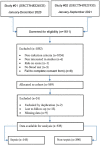Prehospital qSOFA, mSOFA, and NEWS2 performance for sepsis prediction: A prospective, multi-center, cohort study
- PMID: 37144037
- PMCID: PMC10151818
- DOI: 10.3389/fmed.2023.1149736
Prehospital qSOFA, mSOFA, and NEWS2 performance for sepsis prediction: A prospective, multi-center, cohort study
Abstract
Background: Nowadays, there is no gold standard score for prehospital sepsis and sepsis-related mortality identification. The aim of the present study was to analyze the performance of qSOFA, NEWS2 and mSOFA as sepsis predictors in patients with infection-suspected in prehospital care. The second objective is to study the predictive ability of the aforementioned scores in septic-shock and in-hospital mortality.
Methods: Prospective, ambulance-based, and multicenter cohort study, developed by the emergency medical services, among patients (n = 535) with suspected infection transferred by ambulance with high-priority to the emergency department (ED). The study enrolled 40 ambulances and 4 ED in Spain between 1 January 2020, and 30 September 2021. All the variables used in the scores, in addition to socio-demographic data, standard vital signs, prehospital analytical parameters (glucose, lactate, and creatinine) were collected. For the evaluation of the scores, the discriminative power, calibration curve and decision curve analysis (DCA) were used.
Results: The mSOFA outperformed the other two scores for mortality, presenting the following AUCs: 0.877 (95%CI 0.841-0.913), 0.761 (95%CI 0.706-0.816), 0.731 (95%CI 0.674-0.788), for mSOFA, NEWS, and qSOFA, respectively. No differences were found for sepsis nor septic shock, but mSOFA's AUCs was higher than the one of the other two scores. The calibration curve and DCA presented similar results.
Conclusion: The use of mSOFA could provide and extra insight regarding the short-term mortality and sepsis diagnostic, backing its recommendation in the prehospital scenario.
Keywords: early warning scores; mSOFA; point-of-care testing; prehospital; sepsis; septic shock.
Copyright © 2023 Melero-Guijarro, Sanz-García, Martín-Rodríguez, Lipari, Mazas Perez Oleaga, Carvajal Altamiranda, Martínez López, Domínguez Azpíroz, Castro Villamor, Sánchez Soberón and López-Izquierdo.
Conflict of interest statement
The authors declare that the research was conducted in the absence of any commercial or financial relationships that could be construed as a potential conflict of interest.
Figures




Similar articles
-
Prehospital mSOFA Score for Quick Prediction of Life-Saving Interventions and Mortality in Trauma Patients: A Prospective, Multicenter, Ambulance-based, Cohort Study.West J Emerg Med. 2023 Sep;24(5):868-877. doi: 10.5811/westjem.59048. West J Emerg Med. 2023. PMID: 37788027 Free PMC article.
-
Prehospital Early Warning Scores to Predict Mortality in Patients Using Ambulances.JAMA Netw Open. 2023 Aug 1;6(8):e2328128. doi: 10.1001/jamanetworkopen.2023.28128. JAMA Netw Open. 2023. PMID: 37556138 Free PMC article.
-
Comparison of eight prehospital early warning scores in life-threatening acute respiratory distress: a prospective, observational, multicentre, ambulance-based, external validation study.Lancet Digit Health. 2024 Mar;6(3):e166-e175. doi: 10.1016/S2589-7500(23)00243-1. Lancet Digit Health. 2024. PMID: 38395538
-
Evidence reviews for stratifying risk of severe illness or death from sepsis: Suspected sepsis: recognition, diagnosis and early management: Evidence review A.London: National Institute for Health and Care Excellence (NICE); 2024 Jan. London: National Institute for Health and Care Excellence (NICE); 2024 Jan. PMID: 38588370 Free Books & Documents. Review.
-
Comparison of qSOFA and Hospital Early Warning Scores for prognosis in suspected sepsis in emergency department patients: a systematic review.Emerg Med J. 2022 Apr;39(4):284-294. doi: 10.1136/emermed-2020-210416. Epub 2021 Aug 17. Emerg Med J. 2022. PMID: 34404680
Cited by
-
Clinical outcome prediction of acute neurological patients admitted to the emergency department: Sequential Organ Failure Assessment score and modified SOFA score.Front Public Health. 2023 Oct 30;11:1264159. doi: 10.3389/fpubh.2023.1264159. eCollection 2023. Front Public Health. 2023. PMID: 37965516 Free PMC article.
-
Recognition and Awareness of Sepsis by First-Aid Providers in Adults With Suspected Infection: A Scoping Review.Cureus. 2024 Jun 3;16(6):e61612. doi: 10.7759/cureus.61612. eCollection 2024 Jun. Cureus. 2024. PMID: 38962620 Free PMC article.
References
-
- Song JU, Sin CK, Park HK, Shim SR, Lee J. Performance of the quick sequential (sepsis-related) organ failure assessment score as a prognostic tool in infected patients outside the intensive care unit: a systematic review and meta-analysis. Crit Care. (2018) 22:28. doi: 10.1186/s13054-018-1952-x, PMID: - DOI - PMC - PubMed
-
- Shankar-Hari M, Phillips GS, Levy ML, Seymour CW, Liu VX, Deutschman CS, et al. . Developing a new definition and assessing new clinical criteria for septic shock: for the third international consensus definitions for sepsis and septic shock (Sepsis-3). JAMA. (2016) 315:775–87. doi: 10.1001/jama.2016.0289, PMID: - DOI - PMC - PubMed
LinkOut - more resources
Full Text Sources

